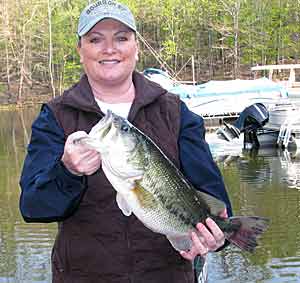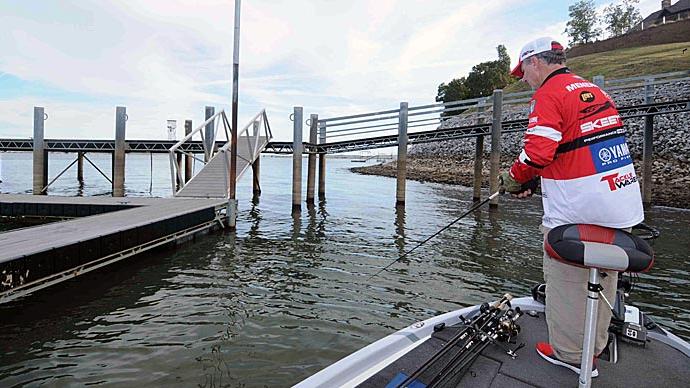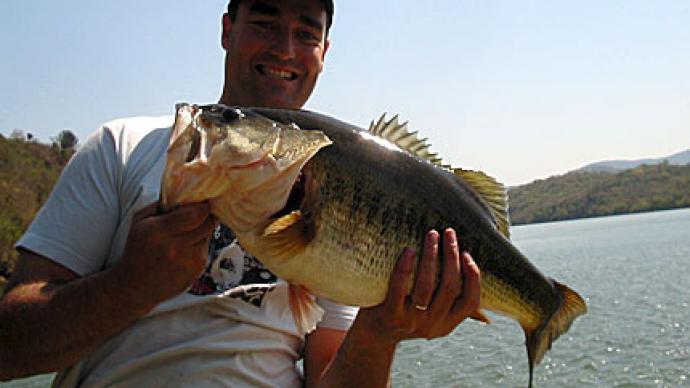
The traditional, Texas-rigged plastic worm bouncing along the bottom is one of the finest ways to catch bass. However, various situations may require a new bag of tricks.
Suspended fish, for example, are a nemesis for anglers. But, if the weight is removed from a Texas-rigged worm – making the lure hold in the top layer of water – suspended bass can be attracted to strike. That’s a trick I’ve found to be incredibly successful, as well as a lot of fun.
Spawn and prespawn are good times to use the floating worm. Bass often suspend or cruise the backs of coves, which warm first in the spring. The same happens during fall when water cools at night, then warms during midday hours.
That’s when I’ll use floating lizards over flooded brush in depths of 6 to 7 feet, especially if brush is submerged. The water temperature may be 55 to 60 degrees in the early morning, but as the sun rises, surface temperatures may jump to 70 degrees. Bass will move into the tops of bushes and suspend there throughout the afternoon.
Using a weighted worm in the bushes places the lure beneath the fish. Also, bass may be too lethargic to chase a spinnerbait. A floating worm or lizard can be the ticket.
The floating worm is also an excellent choice for working grass matted over shallow water. Two years ago, I was fishing coves on a lake that was 2 feet above normal pool. The high water spilled over the broom straw, and bass were crammed in the cover. The thick straw kept hanging my Texas-rigged worm, wrapped around the spinnerbait blades and caught on the hooks of surface-minnow plugs. I tried a floating lizard and caught fish after fish.
Because the floating worm is so weedless, it can be used in the same places you might fish a soft-plastic rat or frog. On the other hand, I think it’s more versatile than traditional heavy-cover lures.
Adding or subtracting weight, which is inserted in the soft plastic, the lure can be presented from top to bottom and at any speed. For weight, I cut off the heads of roofing nails and carry the shanks in my tackle box. I’ll cut the nail to provide the precise weight for the situation.
I insert the nail section into the midsection of the worm or lizard and seal the hole with glue to prevent it from backing out. By inserting the weight in the middle of the lure, it allows the bait to fall horizontally instead of nose first. This type of slow, seductive fall is deadly on spring bass.
Of course, make sure the type of worm or lizard being used is a floater. Some plastic baits will sink too fast with the simple weight of a 5/0 hook.
That’s why I like floating lizards. After adding 1/16 ounce of the nail and a 5/0 hook, it will still float or suspend just beneath the surface. The weight makes it easier to cast and provides the suspended action. However, don’t be afraid to experiment to determine whether fish want the bait on the surface, suspended or falling slowly.
I rig the hook Texas-style. When fishing heavy cover or walking it through bushes, I’ll bury the barb into the worm. When possible, I leave the hook tip sticking out, and if fishing open water, I’ll leave the hook exposed. In either case, use a razor-sharp, wide-gap hook in a 4/0 or 5/0 size.
Most anglers prefer a brightly colored worm because it’s easier to see the suspended lure disappear when a bass grabs it. In most situations, I’ve found subtle colors work just as well.
Work the worm like a surface plug; simply twitch it, swim it, or let it sink slowly into weak pockets or brush.
Hooking fish on floating rigs can be tricky. The key is not to jerk until the fish can be felt. That’s difficult to do when a big bass can be seen grabbing the lure, but wait until the fish has removed all line slack, and its weight can be felt at the end of the line. This tip will significantly reduce the number of fish lost because of a poor hook set.
For more articles, quick tips, and much more, visit HankParker.com.




